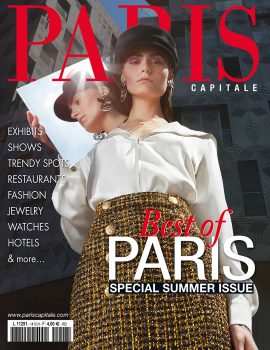His projects are executed worldwide, deeply rooted in their surroundings and transcending styles, cultures, and eras, always perfectly placed and appropriate. His most iconic works are featured in the book “Destinations” (published by Rizzoli), which is structured like a travel diary through 18 locations and projects, revealing the delicate art of balance amid diversity. Upcoming projects include numerous private residences and a palace in London for this aficionado of English architecture, situated in a heritage-listed royal building and expected to be completed after years of renovation—“It’s very English in style but reinterpreted through our French prism,” he notes. Having worked with major publishers like Maison Pouenat, Jean- Louis Deniot is also gearing up to launch his own furniture line, with the first pieces expected in 2025.
Jean-Louis Deniot " My style is structurally French, but my projects are very contextual"
Your style is often described as very French. How do you define it, and has it evolved since 2000?
Jean-Louis Denion : “My style is structurally French, but my projects are very contextual, thus quite blended. They make sense in every country where we work, each telling a new story. With time, we’ve learned that we can be even more eclectic, with clients who appreciate designed, sculptural interiors that play with the concept of time, not clearly belonging to the past, present, or future.”
How has your profession changed since your career began in 2000? For instance, sustainability wasn’t much of a focus back then.
Jean-Louis Denion : “I’ve always used natural and local materials, avoiding the unnecessary transportation of items when each country possesses its own resources that perfectly fit into our projects. Moreover, creating a timeless style ensures that designs last, don’t go out of fashion, and age gracefully. This is what sustainable design is about: creating endu- ring items that won’t be questioned by future owners. Places that change hands while respecting the past. This is a hallmark of French Decorative Arts, achieved by masters like Jean-Michel Frank or Pierre Chareau.”
For many designers, the starting point is the architecture of the building or the client’s desires. What is it for you?
Jean-Louis Denion : “It’s about listening to the building first, understanding what it fundamentally needs. There’s no need to alter what is already quality. We don’t work on the features but on the flaws—transforming unsightly details into advantages like imbalance, awkward corners, sharp angles, cramped elements, and unsightly enclosures. We focus on its limi- tations to make the whole space truly compelling.”
Do you create your own furniture for your projects?
Jean-Louis Denion : “We create a lot, but—with a nod to sustainability—we use a great deal of vintage furniture, which I am truly passionate about. What was made in the past was so well- thought-out and produced that it ages beautifully. If we had to buy similar quality pieces today, it would cost a for- tune. For everything else, we craft pieces that match the scale and spirit of the place, creating a link between vintage and modern elements.”
You are known for your delicate use of color palettes. Is that still the case?
Jean-Louis Denion : “Yes, I try not to make color too prominent. Color is like spices—if you use too much, it overpowers the flavors of other elements. It’s about maintaining a balance, finding the right positioning between a space that breathes, the arrangement of artworks, and the furniture. Neither too much nor too little.”
What is the ultimate architectural creation for you?
Jean-Louis Denion : “Without hesitation, the Louvre. It originally encapsulated the entire richness of French decorative arts, architecture, decoration, and furniture. The various architectural layers through centuries have always harmonized with one another. In terms of eclecticism and balance, it’s an extraordinary structure. My vision of Paris revolves around what I consider the world’s most beautiful museum.”
- www.deniot.com



